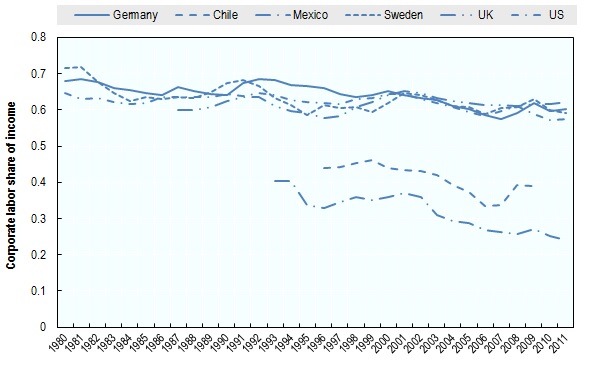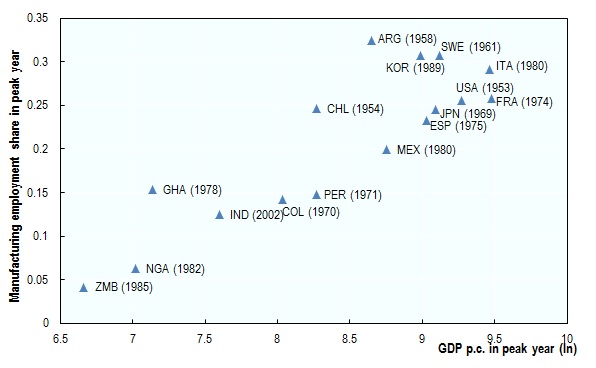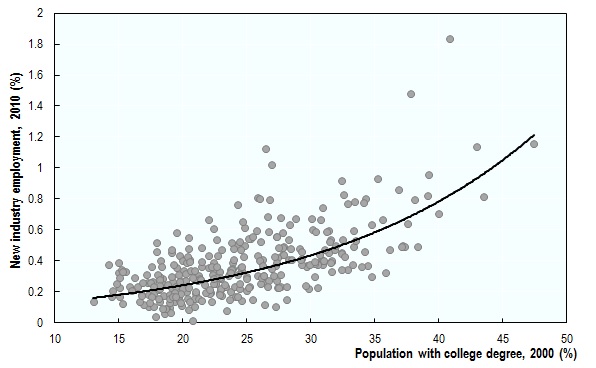By Stijn Broecke.
 Today the OECD has released a new working paper by Thor Berger and Carl Frey (famous from his work on the automatability of jobs) which provides a systematic overview of the literature examining the impact of digitalisation on labour markets. By now, the stylised facts are becoming well-known:
Today the OECD has released a new working paper by Thor Berger and Carl Frey (famous from his work on the automatability of jobs) which provides a systematic overview of the literature examining the impact of digitalisation on labour markets. By now, the stylised facts are becoming well-known:
- Over the course of the 20th century, technological change has increased the demand for skilled workers more than for unskilled workers (i.e. technological change has been skill-biased)
- In more recent decades, computers and robots have been increasingly used as substitutes for workers performing routine activities (i.e. technological change has been routine-biased)
- The latter has resulted in a “hollowing out” of the labour market in many countries in terms of jobs involving mid-level skills, combined with an expansion of low-skilled and high-skilled (i.e. job polarisation)
- While technologies have displaced workers in a wide range of jobs, they have equally created new tasks, occupations and industries. The overall impact on employment is therefore ambiguous.
However, the paper also highlights a few other findings from the literature, which are perhaps a little less well-known. Here are just three of them.
1. Technological change has been capital-biased
In addition to being skills-biased and routine-biased, Berger and Frey argue that the available evidence increasingly points to technological change being capital-biased (CBTC), and that this is the main explanatory factor behind the decline in the labour share of income over recent decades in many countries (see Figure 1). Between 1945 and 1980, the cost of computing in the United States declined at 37% per year and, since 1980, this annual price decline has accelerated to 64% (Nordhaus, 2007). Meanwhile, there has been an explosion in computing power and, as a result, firms have been massively substituting capital for labour. According to Berger and Frey, there is an emerging consensus that these technology-driven changes do a better job at explaining the declining labour share than do other factors (such as the decline in collective bargaining or the rise in import competition from low-wage countries).
Figure 1. The labour share of income has been declining, 1980-2010
Notes: This figure reports the corporate labour share (compensation of employees in the corporate sector divided by corporate gross value added) in five OECD countries.
Source: Karabarbounis & Neiman (2014).
2. Emerging economies are experiencing premature deindustrialisation
Technological change is not only affecting advanced economies but also emerging ones – although the nature of the effect on the latter is perhaps more disputed. Some argue that emerging economies are at a comparative advantage and that new technologies will allow them to “leapfrog” advanced economies. Others, however, believe that recent developments in robotics and 3D printing allow firms in advanced economies to locate production closer to domestic markets in more fully automated factories, as opposed to locating production in emerging economies. As a result, some emerging economies are experiencing “premature deindustrialisation” – i.e. the manufacturing share of employment in these countries is peaking well below the levels experienced by advanced economies during their industrial development, which leaves them in a middle-income trap (Rodrik, 2015) (Figure 2).
Figure 2. The manufacturing share of employment in emerging economies is peaking well below the levels experienced by advanced economies
Notes: Employment data is based on Timmer et al. (2014) and GDP per capita is obtained from Bolt and van Zanden (2014) and are measured in 1990 Geary-Khamis dollars. The year in which the manufacturing employment share peaked is given within parentheses.
Sources: Timmer et al. (2014) and Bolt and van Zanden (2014).
3. Technological change exacerbates regional disparities
Finally, while most of the research has focused on the job polarisation of national labour markets, there are also indications that technological change may be exacerbating regional disparities in economic and labour market outcomes. In the United States, convergence in incomes between states has slowed down since 1990 and, in most European countries, regional income disparities have increased. Berger and Frey (2016) argue that this is partly driven by technological change which, since the Computer Revolution of the 1980s, has created more jobs in those areas where there are more skilled workers – i.e. primarily in cities. Their analysis (which focuses on the United States) shows that cities experienced more than 40% higher growth in new industry development between 2000 and 2010 relative to rural areas. In particular, cities that were already dense in college-educated workers experienced substantially more additions of new industries (Figure 3). In other words, initially skilled cities have created even more jobs for skilled workers, strengthening regional disparities.
Figure 3. More jobs have been created in those areas where there are more skills workers
Notes: This figure shows the percentage of workers in 2010 who were employed in technology-related industries that were created between 2000 and 2010 against the percentage of the population with a college degree in 2000, for 321 US cities. Also shown is a fitted regression line. See Berger & Frey (2016) for the underlying data.
Source: Berger & Frey (2016).
Policy implications
The paper concludes by taking stock of the policy implications of digitalisation, deindustrialisation and the future of work. It is clear by now that skills policies will play a central role in making our societies more resilient to the changes that are ahead – including skills upgrading, and ensuring a better use and distribution of existing skills. At the same time, active labour market policies (job-search assistance, training programmes, etc.) will need to ensure that individuals who are displaced as a result of technological change do not fall into poverty and are helped to find a new job quickly. Related to this, countries may need to strengthen policies to increase geographical mobility, especially amongst the unskilled, and which target the cost of housing and moving. Finally, labour market institutions such as employment protection legislation and wage-setting mechanisms can also have an impact on labour reallocation as well as on economic inequality – but there are sometimes trade-offs that need to be resolved based on societal preferences.




Reblogged this on Datanomics.
LikeLike